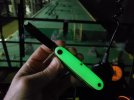- Joined
- Aug 28, 2011
- Messages
- 1,588
After using mostly modern folders for a while I wanted to use some traditional knives. Some of them were put away a little dull a while ago, others had a good edge and a leather strop made them even better.
Using diamond stones freehand I really struggled getting an acceptable edge on them. So I tried some sandpaper on a flat surface, and then on a mouse pad for a convex edge. It was rather frustrating removing material without ending up with a decent edge.
Is there any trick to sharpening thin 1095 blades that I've forgotten? Getting frustrated probably didn't help my sharpening skills.
Using diamond stones freehand I really struggled getting an acceptable edge on them. So I tried some sandpaper on a flat surface, and then on a mouse pad for a convex edge. It was rather frustrating removing material without ending up with a decent edge.
Is there any trick to sharpening thin 1095 blades that I've forgotten? Getting frustrated probably didn't help my sharpening skills.


 . Most people cannot use a sharpening steel/rod because they cannot get or keep a consistent angle, eg. you sharpen at 15deg. on a stone, then on the sharpening steel they are between 12-22deg on each pass. Those TV chefs
. Most people cannot use a sharpening steel/rod because they cannot get or keep a consistent angle, eg. you sharpen at 15deg. on a stone, then on the sharpening steel they are between 12-22deg on each pass. Those TV chefs